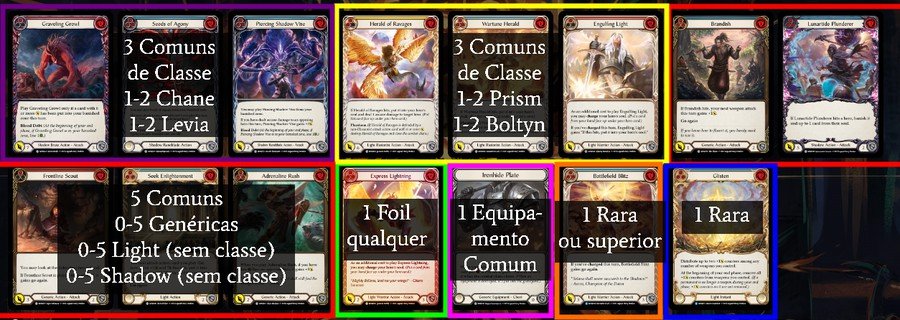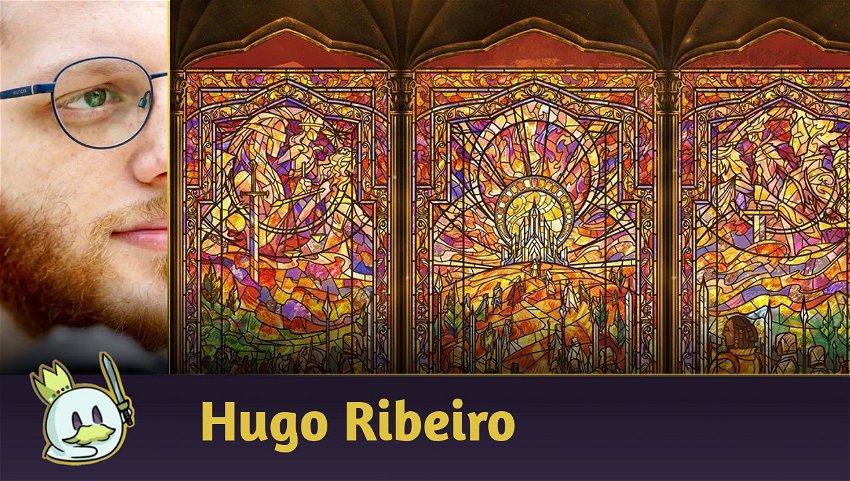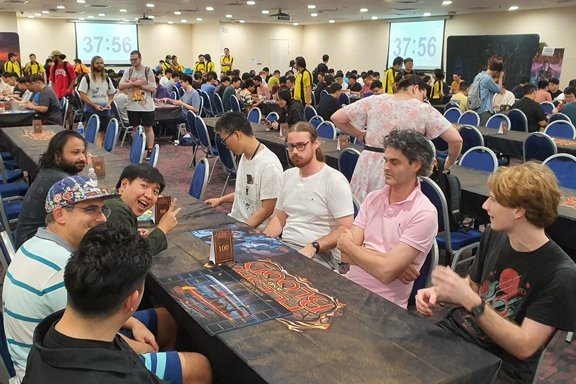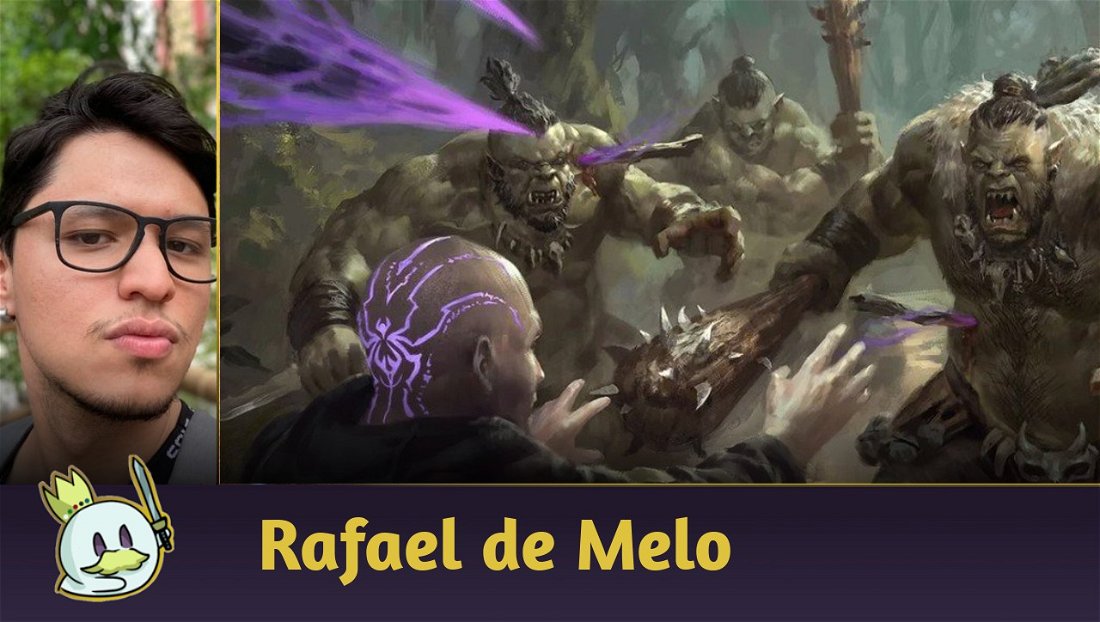The Monarch Draft Season
The Monarch set was released in early 2021, in the midst of the pandemic. As a result, few had the chance to experience its limited Sealed and Draft formats.
With the release of Dusk till Dawn in July 2023, however, LSS decided that we would have one more chance to try Monarch's Draft format. The format will be played both in the Dusk till Dawn prerelease, and in the National championships that will take place in August of this year.
Despite being an old format, there is little information online about it, as it was not played much in its day. Now, both casual and competitive Flesh and Blood players will have a new opportunity to experience one of the best Draft formats the game has ever had.
Introduction to the format

The Draft format in Flesh and Blood is very similar to Magic: the Gathering, or other games with draftable sets. Eight players sit around a table and receive 3 set packs, in this case, Monarch. Each player must choose a card for their deck and pass the rest to the player next to them.
During the first pack we will be passing the remaining cards to the left, in the second pack to the right and, in the third, again to the left.
At the end of the 3 packs, we must assemble a deck with at least 30 cards, being able to fill the remaining cards with Cracked Bauble tokens, in case we don't have enough cards. Our hero and their weapon don't need to be drafted, they can be freely chosen after the draft, since they are also tokens.
In Monarch, we can choose from four heroes, each from a different class. Two of them from the Light talent: Prism (Illusionist) and Boltyn (Warrior); two of the Shadow: Chane (Runeblade) and Levia (Brute). All four are valid draft picks, and it's important to be familiar with the strategy of each one, so we can choose the right hero for our seat at the Draft table.
The Monarch Pack Collage: Learning to Read and Send Signals
In FAB, unlike some other TCGs, the collage of Draft packs is usually very well-defined so that it is possible to predict how many cards of each type we will receive and, from that, send signals to the players who are drafting to our left and reading the signals of players drafting to our right.
Due to the restrictive nature of the game's classes, it's important to be aware of these signs so that we don't end up splitting a hero with half the table, leaving the others wide open.
The Monarch packs contain 15 cards and the collage is as follows:

- 3 common cards of the Runeblade or Brute classes, whether they have the Shadow talent on them. This pack slot will be distributed among the heroes Chane and Levia. We will therefore have either 2 cards from Chane and 1 from Levia, or 2 cards from Levia and 1 from Chane. These cards can be of the following types: Runeblade, Shadow Runeblade, Brute and Shadow Brute.
- 3 common cards of the Illusionist or Warrior classes, whether they have Light on them. This slot in the pack will be distributed between the heroes Prism and Boltyn. We will therefore have either 2 cards from Prism and 1 from Boltyn, or 2 cards from Boltyn and 1 from Prism. These cards can be of the following types: Illusionist, Light Illusionist, Warrior and Light Warrior.
- 5 common cards between Generic cards and classless talent cards, i.e. Light only or Shadow only cards. The number of talent cards is not fixed, and therefore, it is common to find packs without cards of one of the talents.
- any 1 Foil* card;
- 1 Common Equipment card;
- 1 rare or higher card;
- 1 rare card.
Knowing this information, right in the first pack of the Draft we can read the signals that the players to our right are sending us, as well as we can send signals to the players to our left.
It works like this: if you're drafting the first pack and, right after the second pick, you receive a pack without any common Runeblade or Shadow Runeblade cards, that means that the person on your right has already drawn a card for Chane from the pack, as there is always at least one common Runeblade or Shadow Runeblade card in each pack. That would be a strong signal that the player to your right is sending you that they're drafting Chane.
Likewise, if you take a common Warrior card from a pack where, in the commons slot, there are 2 Illusionist cards and 1 Warrior card, you will be sending a strong signal to the person to your left that Boltyn is already being drafted and that person should stay out of that hero.
If multiple players are drafting the same hero, they will all be handicapped. Therefore, it is of common interest to send signals and read the received signals, so that everyone can choose the right hero for their seat.
Another strong signal that can be sent is when someone chooses to pass a forceful card from that hero, such as a V of the Vanguard (a bomb on Boltyn), or a Soul Reaping (a bomb on Chane). If you receive one of these cards, it is a strong indication that that hero has not yet been chosen by the players where the pack passed.
Receiving common “premium” cards from each hero is also a good indication that the hero of that class is open. Some examples are Herald of Protection (1), Take Flight (1), Seeds of Agony (1), and Dread Screamer (1).
Picking common Generic and Talent cards
Here are some strong and/or versatile cards from the set, among the classless common cards. This list of generic and talent cards is not exhaustive, and is intended only to indicate some priority picks.
As they can be used on several heroes, these cards are often disputed, and are also great picks at the beginning of the first pack, if you intend to stay open while reading the signs of the players to your right.
Poppers

Poppers are cards with 6 or more power that, in addition to being good offensive cards, also interact with the keyword Phantasm.
Some Prism cards, like Herald of Protection (1), have this keyword. This means that if a card with Phantasm is defended by a card with 6 or more power (a popper), which isn't of the Illusionist class, the attack with Phantasm will be destroyed, which can give a huge card and tempo advantage against the Prism player whose card popped.
Poppers are therefore priority picks, both due to the strength and presence of Prism in the format, and due to the low availability of poppers in the set.
Equipment

Monarch's equipment is more powerful than most FAB sets, and is also a priority pick for all heroes.
Blood Drop Brocade can give you the resource you need to complete your game plan, or even can be used defensively, with an Ironhide card.
Ironhide equipment is also important and has several uses. Whether it helps block attacks with Dominate; allows "blocking" with a non-defense card, if playing as Levia; helps to block Boltyn's attack after a charge; etc. These are even better in multiples. Three Ironhide cards can allow you to block 6 damage with a single blue pitch!
Stubby Hammerers is very powerful in Chane, being able to contribute more than 3 damage in a combo turn. It's also a great choice for Boltyn if you can't get access to a Gallantry Gold.
Other Generics

Surging Militia (1) is great for threatening damage, being quite difficult to block effectively, especially if combined with a card that increases its power, like Warmonger's Recital (1).
Monarch has few cards with Go Again. Therefore, cards like Warmonger's Recital (1) and Brandish (1) end up having enough value for several strategies to be able to use full 4-card hands. Brandish (1) works great on Boltyn and Chane, but is also surprisingly effective on Levia, as her weapon, Ravenous Meataxe, costs only 2 resources.
Many already know the strength of the duo Belittle (1) and Minnowism (1). Using a Belittle (1) to fetch a red or blue (or even yellow) Minnowism (1) is extremely efficient. This duo is better, however, on heroes with less powerful attacks, being priority picks for Chane and Boltyn.
Light and Shadow

Both Halo of Illumination, and Ebon Fold, are extremely versatile on their respective heroes. Chane, Levia, Prism and Boltyn all manage to make excellent use of them.
Illuminate (1) is an excellent card to block with the rest of the hand and hit with, featuring a respectable “zero to 4”, with on-hit going to the Soul. Plus, it blocks 3, making it even more versatile.
Lunartide Plunderer (1) is one more popper that the Shadow talent gains, both in red and yellow. Red is also a very efficient 2 card attack for 7 damage. The on-hit can also be relevant: either to threaten your opponent's Soul, or to banish a card with 6 or more power if you're playing Levia.
Monarch's Heroes Strategies
Prism

Prism is possibly the easiest hero to draft in the set. It's not too difficult to put together a functional Prism deck, as it can attack on multiple fronts.
Her position is unique in Monarch Draft, due to her ability to put permanents on the field and extract value from them. It can be difficult, however, to find windows to use her auras, such as Genesis, as they have a high cost, in addition to being unable to block.
Illusionist's attacks are strong and efficient, but come with the cost of the Phantasm keyword, and can be "popped" when blocked by attacks with 6 or more power that aren't Illusionist cards.
Except for Prism, all other heroes in the format have some mechanics who make them easily susceptible to fatigue. Boltyn uses extra cards to charge; Chane banishes the top cards with Soul Shackle; and Levia, in addition to having the mechanic of drawing and discarding a card (reducing your cards in the deck), is very susceptible to dying with its own Blood Debt cards if it doesn't manage to kill its opponent fast enough.
The best Prism decks, therefore, are those that manage to take advantage of both its powerful attacks and its defensive capacity, threatening fatigue if the opponent is unable to “pop” its attacks and needs to defend them with more than one card.
Prism is also excellent at blocking evasive attacks such as Dominate attacks and arcane damage attacks, being the only one able to prevent them with any consistency. In addition to the defensive possibilities that the Spectral Shield mechanic allows, it is also possible to play her offensively. If Prism has an aura on the field, she has the most fatigue-threatening attack of the format, pitching a blue card to hit 4 with Go Again, thanks to Iris of Reality.
Dream Weavers is a key card in the deck, allowing you to perform powerful turns such as a Phantasmify (1) followed by a Herald of Tenacity (1), without running the risk of running into a popper. Blinding Beam (1) is also a good choice to try to dodge poppers and catch your opponents off-guard.
Boltyn

Boltyn has a great offensive and defensive arsenal, with many cards and equipment that defend well and his Charge mechanic, which makes it difficult for opponents to block his cards.
Its Charge mechanic can, however, require plenty of cards in hand to be able to make an efficient turn, due to the need to put a card in the Soul during that turn. The payoffs for using an extra card, however, can be great: Valiant Thrust (1) and Bolting Blade are powerful attacks to use after a Charge.
Boltyn's best turns are therefore often 5-card turns with one or more Take Flight (1). Its natural Go Again after the first Charge, without needing Boltyn's ability to recover its Action Point, allows for "go wide" turns that are difficult to block. Attacks that naturally gain power, such as Adrenaline Rush (1), can also start or extend a combat chain, due to the possibility of gaining Go Again with Boltyn's ability.
Thanks to Gallantry Gold and his axes, Hatchet of Body and Hatchet of Mind, Boltyn has access to the best one-card hand of the format. With a card in the Soul, activating Gallantry Gold and pitching a blue card, it is possible to present a turn of 7 damage, recovering lost time, after spending a turn blocking.
Last but not least, Boltyn also has access to a card that is possibly the biggest bomb in the format: V of the Vanguard. With a blue pitch and two Light cards in hand, it is possible to present a turn of 14 damage with only 4 cards, in which your opponent will have a great difficulty in blocking, due to Boltyn's first ability.
Chane

Chane's deck is probably the best deck in the format. It's not always easy, however, to build the best deck for him. If you are the only Chane on your Draft table, you will have everything to have a very smooth journey ahead, but if you are sharing this hero with 2 other players, it gets way harder to accomplish this feat.
Chane seems, at first glance, just an aggressive deck, but it is possibly the most difficult deck in the format to pilot well. The Soul Shackle mechanic means that the more the game progresses, the more cards you banish from the top of your deck. You will have access to many of these cards, as if you were drawing more cards per turn, but the cost can be high. Cards that can be used from the banished zone have the Blood Debt mechanic and, if you fail to use them that turn, they will consume 1 life. Furthermore, as you banish more and more cards from the top, there is a real risk that you will end up fatigued if you haven't prepared your late game well with a pitch stack.
Chane's strategy is generally to try to lower your opponent's life during your first turns, while preparing your pitch stack so that, from the sixth turn, you start banishing the cards you started pitching, so that you can prepare a huge turn that few can handle. This combo turn is usually composed of combinations of one or more Seeds of Agony (1), with one or more Rip Through Reality (1), plus other cards that can be played from your banished zone, such as Piercing Shadow Vise (1), or Rift Bind (1).
To better prepare these turns, it will take a lot of practice and deck counting. For example, a 34-card Chane deck that starts playing first and does 1 Soul Shackle per turn, at the end of turn 5, will have banished 10 cards (0+1+2+3+4) drawn 24 cards during the game if you used all 4 of your cards each turn. This way, this deck will start turn 6 by banishing the first 5 cards it pitched at the start of the game.
Arcane damage cards like Seeds of Agony (1) and Rifted Torment (1), but also Vexing Malice (3) and Arcanic Crackle (3), are great ways to finish the game and cross the finish line before fatigue, as there are few ways to prevent this type of format damage. Its base weapon, Galaxxi Black, is also capable of threatening arcane damage each turn.
It's also worth noting that Chane's class equipment, Aether Ironweave, is quite potent, especially on combo turns. In addition, Chane has access to a card that disputes the position of the strongest bomb in the format: Soul Reaping, an extremely efficient card, especially if you are attacking a hero with one or more cards in their Soul.
Levia

Levia is a hero with powerful attacks and access to the format's most efficient base weapon, Ravenous Meataxe. Her game plan, however, can be difficult to execute correctly.
Levia's mechanic means that, after you start banishing your cards from your graveyard to play your most powerful attacks, you need to either kill your opponent right away, or keep constantly banishing a card of 6 or more power from your graveyard per turn. Otherwise, your own cards banned with Blood Debt can and will kill you.
It is critical, therefore, to draft cards with 6 or more power, trying to avoid those with Blood Debt that doesn't meet this requirement.
Levia's strategy can be divided into two steps:
First, at the beginning of the game, it will be necessary for us to block a lot to preserve our life and fill the graveyard. At this point, we still can't start hitting with the strongest cards, which have an additional cost of banishing cards from the graveyard.
Therefore, we use cards like Smash with Big Tree (1), Deadwood Rumbler (1), Generic attacks and attacks with Ravenous Meataxe to try to reduce the opponent's life. Meanwhile, we attempt to prepare a pitch stack by saving our most powerful cards for the second cycle.
In a second moment, after gathering something around 10 cards in the graveyard, with a good number of cards with a power of 6 or greater, we can pivot to the offensive plan, using cards like Dread Screamer (1), Unworldly Bellow (1) and Hooves of the Shadowbeast to make “go wide” and efficient turns. Once we start hitting with these stronger cards, we can't stop anymore; otherwise we'll die to our own Blood Debt cards.
As a tool to try to cross the finish line before our own cards kill us, we have Two Rare cards that allow Dominate attacks: Convulsions from the Bellows of Hell (1) and Writhing Beast Hulk (1). It is essential to have at least one of them in the deck to close the game.
Conclusion and Study Material
Arsenal Pass Ep5 - Mastering the Heroes of Monarch Limited
Fab with Matt - Monarch Limited Breakdown
Calling Auckland 2021 - Day 1
Calling Auckland 2021 - Day 2
- Kotarou's massive guide to drafting Monarch
I hope our Guide has helped you to better understand the Monarch Draft! Any questions or suggestions, I'm available in the comments.
Until next time!












— Comments 0
, Reactions 1
Be the first to comment